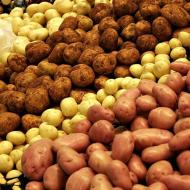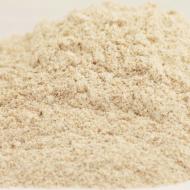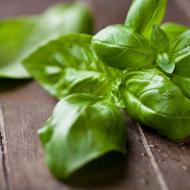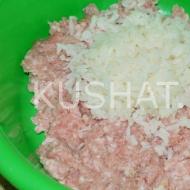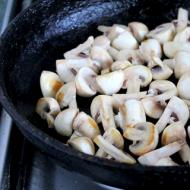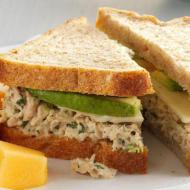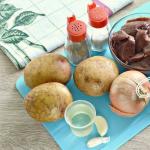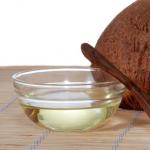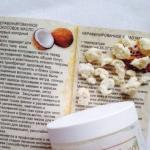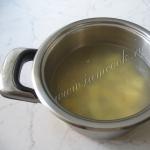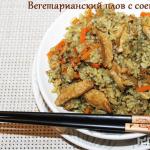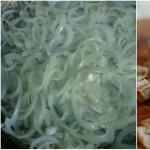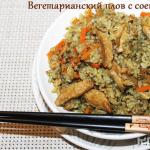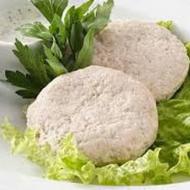
Cottage cheese cake - a recipe for Easter without yeast. The most delicious Easter cake - recipe with photo. Easter cake without yeast with cottage cheese Easter cake "Glorious" with saffron
Step by step cooking Easter cake without yeast on kefir:
- Sift the flour through a sieve to make the cakes airy.
- Pour granulated sugar into kefir, mix and leave for 2 minutes.
- Wash the lemon and grate the peel on a fine grater.
- Steam the raisins in boiling water for 15 minutes, then pat dry with a paper towel and sprinkle with flour.
- Melt the butter in a water bath, add sugar, salt, vanilla and lemon zest. Stir and pour kefir with soda.
- Combine flour with liquid mass and raisins. The consistency of the dough should be very liquid.
- Grease the baking molds with butter and pour the dough. If you fill them 1/2 of the height, then the cake will turn out to be light and airy, and 3/4 - dense and tight.
- Heat the oven to 180 ° C Celsius and put the Easter cakes to bake for an hour and a half on the lower shelf. If the cake is larger, it will take longer to bake. Readiness can be checked by puncturing a dry toothpick - if it is dry, Easter is ready.
- Remove the baked holiday cake without yeast from the oven, cool well, remove from the molds and cover with any glaze.
Recipe number 2: sourdough cakes without yeast
Easter sourdough bread is an old Russian recipe that makes baking easy and delicious. Easter cakes on sourdough remain fresh for a long time without changing their taste.
Ingredients:
- Wheat flour - 1.5 kg
- Sourdough - 300 g
- Milk - 600 g
- Eggs - 10 pcs.
- Cognac - 200 ml
- Sugar - 500 g
- Candied fruits - 250 g
- Butter - 300 g
- Zest of one orange
- Vanilla sugar - 3 tsp
- Salt - 2 tsp
- Boil milk and cool to 30–35 °C. After, dissolve fresh sourdough and 750 g of flour in it. Mix the products and leave in a warm place, about 25-30 degrees, for about 3 hours, so that the dough comes up, becomes bumpy and loose.
- Cream the butter with a mixer until white. Then add one at a time egg yolk continuing to beat the mass. Then add sugar, vanillin and continue to beat the mass. The more magnificent it is beaten, the better the cake will turn out.
- Wash the orange, grate its zest on a fine grater and add it to the whipped yolks.
- Pour cognac into the approached dough, pour a glass of flour and mix. After, add the butter mixture and knead the dough, gradually adding all the remaining flour. Knead the dough so that it stops sticking to your hands.
- Whip the egg whites into a stiff, thick, stable foam and add to the dough, then the Easter cakes will turn out light and airy.
- The last step is to put candied fruits into the dough, stir them in, cover the dough with a clean towel and leave for an hour and a half.
- After this time, generously grease the molds with butter, fill them 1/2 of the volume with dough and leave to stand for 15-20 minutes. After, send to the oven heated to 180 ° C for 1.5 hours. Check the readiness of baking with a wooden skewer, if there is no sticky dough on it, Easter is baked.
- Remove the finished cake without yeast from the oven, cover with a dry towel and let cool. Then remove from the mold and cover with fondant.
How to make a sourdough starter

In order for Easter without yeast to turn out lush, tasty and fragrant, you should make a leaven that will help achieve an amazing result of a delicious Easter cake.
Sourdough Ingredients:
- Flour - 150 g (any: wheat, rye, whole)
- Water - 150 ml
- Mix 50 g of flour with 50 ml of water. The consistency of the mass should be pasty, like thick sour cream. Cover the starter with a towel and leave in a warm place for a day, while stirring it 3-4 times.
- After a day, the mass will be covered with small, rare bubbles. This means that you need to add another 50 g of flour and add 50 ml of water. Knead the starter and again leave for a day under a dry towel in a warm place. Stir again 4 times a day.
- After 2 days, repeat the procedure: add the remaining flour with water, knead the mass, cover with a towel and leave for another day.
- The next day, the starter will increase in size and will consist of a foam cap. This means that it is ready for further use in baking.
Easter chores continue, and this time, I propose to bake cottage cheese cake without using yeast on your own. delicious recipe with photo. No dough, and long waits for the test, everything is quite simple and fast.
And if you do not want to mess with yeast dough, or you absolutely do not have time for this .... I strongly advise you to cook Easter cake for Easter according to such a quick recipe with step by step photos. It will take no more than two hours, and beautiful holiday pastries will delight you with their stunning views and amazing taste.
Be sure to check out these recipes:
Cottage cheese cake turns out to be incredibly tasty, with a very juicy crumb of creamy taste and citrus aroma. Therefore, I want to warn you right away, cook more, it is eaten instantly, and there may not be enough for everyone.
I also want to note that a huge plus of this baking is that it does not get stale for a long time, and you can cook a cottage cheese cake for Easter in advance. Ready-cooled Easter cakes can be wrapped in foil and placed in the refrigerator, and just before the holiday, decorate with icing, multi-colored powder, and the symbol of the holiday on your table.
And how to bake cottage cheese cake for Easter without yeast at home, I, as always, will tell you with all the details.
Cottage cheese cake recipe

Products used:
- Flour - 240 gr.
- Cottage cheese of any fat content - 400 gr.
- Sour cream - 200 gr.
- Egg - 4 pcs.
- Sugar - 100 gr.
- Corn starch - 60 gr.
- Raisins - 200 gr.
- A teaspoon of soda.
- Lemon juice.
- Zest of one lemon.
The size of paper forms used in the recipe:
- Width 8 cm - height 9 cm.
- Width 11 cm - height 9 cm.
How to cook cottage cheese cake without yeast:
Take the zest from the lemon. But, first, we wash the citrus well, dry it with paper towels, and use a fine grater to remove the entire upper yellow layer of the peel from it, without touching the white. Pour the resulting zest into the cottage cheese and then add sugar, sour cream, and egg yolks. Put the squirrels in the refrigerator to cool.

Blend everything with an immersion blender until smooth. Look at how smooth a beautiful mass turned out and almost no curd grains are visible.

Now we need to extinguish the soda. We place it in a small container, pour over lemon juice. You see, there was a reaction, the soda foamed, hissed, mix it into the curd mixture with a cooking spatula.

Add raisins and mix again. My raisins are very soft, so I just washed them, but if yours is very wrinkled and hard, then fill it with hot water for ten minutes, then drain the water, dry it, and only then fall asleep.

In a clean bowl, beat the chilled egg whites with a pinch of salt with a regular mixer until stiff peaks. Look, they have greatly increased in volume, turned into a snow-white and airy mass, which does not spill out when the bowl is turned over.

The protein mass is gently introduced into the curd mixture with smooth movements of the spatula from the bottom up.

In the resulting lush mass, it remains only to add flour. As with all Easter cakes, flour must be sifted, and preferably several times, so that our pastries are soft and airy. Sift the first time beforehand, and then just before adding. So, we take the flour along with the starch, sift through a sieve, gradually carefully mix it into the curd mixture.

You see, it turned out incredibly tender, light curd dough. And at this stage, the curd dough for Easter cake is ready, it can be distributed according to the forms.

The dough is the most delicate, so use only small and narrow forms; in wide forms, pastries can sag. We fill the molds 2/3 with dough, put them on a baking sheet, cover with foil, and set in a preheated oven to 180 ° C to bake for 35–40 minutes.

Remove the foil five minutes before the end of baking to brown the tops. For my oven, this time is enough, but you are guided only by your oven. Be sure to check by piercing the pastry with a long thin wooden stick, if it is dry when you take it out, then the cottage cheese cake without yeast is ready.

That's all the preparation, I think you have seen how simple and fast everything is. It remains only to decorate our cakes with delicious icing. Now I have prepared a glaze with gelatin, which does not crumble and does not stick. How to prepare such a glaze, So, decorate, one Easter cake, dip into the glaze, scroll a little, and take it out. A very convenient way to apply a beautiful even hat.

Sprinkle with various beautiful powder, I have it in the form of beads.

And now comes the most desired moment, we will cut our culinary creation. Let's see how it is in the context? Oh, what a beauty, look! Cottage cheese cake is so tender, not dry, but very juicy and porous. Just beautiful!

Perhaps someone will not understand such an alternative, because this is a completely non-classical recipe for Easter cake, and it turns out to be small in size, reminiscent of a cupcake. But agree that great option a quick tasty cottage cheese cake for Easter, unlike a store-bought cake.

Bake with pleasure and great desire (not only Easter cakes), and your culinary creations will be created quickly, simply and always successfully! Happy holidays to you, and bon appetit!
And one more addition.
Kulich is a traditional treat served at Easter.
This is a yeast product of varying degrees of richness and different in size, but always high. Among Catholics, in addition to yeast cakes, they also prepared sand, the so-called "women".
Made in the form of a cylinder of dough, often with raisins, topped with powdered sugar or icing. As spices are used: vanilla, cardamom, nutmeg.
After the end of the Easter service, they broke their fast with Easter cake after Great Lent: sometimes already in the church, parishioners treated each other and the clergy with pieces of their Easter cake, but more often at home at the Easter meal, the head of the family divided it according to the number of household members.
Kulich is a similarity of church artos - a large bread with an image of a cross with a wreath of thorns (as a sign of Christ's victory over death) or an image of the Resurrection. It is one of the oldest symbols of the Resurrection of Christ (the apostles at meals left the middle seat at the table empty and put the bread meant for Jesus on it). On the days of the celebration of Easter, the artos is carried around the church with a procession and left on a special table, following the example of the apostles, and on Saturday of Bright Week, after the blessing, they are distributed to believers.
Kulich is the domestic equivalent of artos. For its preparation, yeast is used, which replaces unleavened bread from the Old Testament. For this reason, symbolically, a yeast cake is a transition from the Old Testament to the New.
By the way, the consecration of Easter cakes and other Easter food is our custom. In Greece, for example, this is not the case; there, simply, at the end of the Easter service, a prayer is read for the resolution of fasting. But on the other hand, consecrating Easter cakes is so fun and festive!


This recipe is part of the "Cooking Together - Cooking Week" campaign. Discussion cooking on the forum -
Meet the cottage cheese yeast-free version! A recipe with a step-by-step photo and a detailed algorithm is within the power of even the most inexperienced chefs.
We need:
- Flour - 1.5 cups
- Eggs - 2 pcs.
- Butter - 150 g
- Curd - 250 g
- Sugar - 350 g
- Soda - 0.5 tsp
- Vinegar - 3-4 tbsp. spoons
- Raisins, vanilla - to taste
How we cook.
Break the eggs into a deep bowl.
The mixer comes into play - we will work with it non-stop until we add sugar.
Here's how to do it step by step:
- We begin to beat the eggs at low speed, gradually increasing the speed. Beat vigorously and long enough - 3-4 minutes. We achieve a thick egg foam - as in the photo.
- Now we begin to pour sugar into the bowl, without stopping whisking. Small portions directly to the working whisk. Ideally, most of it will dissolve in the foamy whirlpool. If, after a few minutes, crystals still remain on the whitened surface of the mixture, no problem. The main thing is that the mixture turned white and the main sweetness combined with the eggs.
Now we melt butter. It should be liquid, but not hot (!). Pour it into a common bowl. We start the mixer again - 3-4 minutes, so that the components make good friends.

It's the turn of the curd. Fat content and texture are up to you. If you chose a sour curd, you can add a little more sugar to the cake - for balance.
We distribute the cottage cheese and mix 1/3 of all the flour into the dough.
We extinguish the soda with vinegar and pour into a bowl. Stir again - carbon dioxide will help the pastry to become fluffier.
We turn on the mixer and beat the dough well with the cottage cheese and the first portion of flour.
We add a little vanillin, on the tip of a knife, so that Easter does not taste bitter. Add the rest of the flour and beat. The dough became thicker than sour cream - we did everything right.
Don't doubt consistency. In this recipe, the mixture always turns out thick (!)
The last we fall asleep raisins. An alternative is candied fruits or nuts. Mix again.


We need a special form - with a round hollow in the middle. The product bakes well in it. If this assistant is not available, use traditional containers of medium diameter (9-10 cm).
Lubricate the surface of the mold generously with vegetable oil. We shift the dough and let it stand in a new house - 5 minutes.

Preheat the oven to 200°C. We put the form with the dough inside, lower the temperature to 160 ° C and bake for 40-60 minutes. We check the readiness with a toothpick - nothing should stick to it.

Sprinkle our handsome man with powdered sugar. We cut it only when it has completely cooled down.

Easter cake on kefir
Another holiday hero who rises well and is great with new ideas.
What is curious: there are not even eggs in this pastry! And using brown sugar, you get a nice moist dough. The glaze will also sparkle with new colors. A recipe with a photo step by step will easily lead you to an excellent result.
- Cooking time - up to 1.5 hours
For 3 Easters, 9 cm in diameter, we need:
- Wheat flour - 750 g
- Sugar - 1 cup (250 g)
- Baking powder - 1 tbsp. spoon without top
- Kefir - 600 g (2 cups of 250 ml with a "hike")
- Soda - 1 teaspoon without top
- Dark raisins - 150 g
- Poppy seed - 25 g (about 1 tablespoon)
- Oil for greasing molds
- Decorations - to taste: coconut and chocolate chips, confectionery powders, etc.
For glaze:
- Kefir - 2 tbsp. spoons
- Powdered sugar - 150 g (you can grind sugar in a coffee grinder)
- Corn starch - 2 tbsp. spoons without a slide
- Lemon / orange juice - 1-2 teaspoons
Important details.
- We bake in portions in standard high paper forms - 9 cm in diameter.
- It is especially delicious to mix 3 cups of white flour with 1 cup of whole grains.
- Take yesterday's kefir, the day before yesterday - with obvious sourness.
- It is interesting to experiment with brown sugar. The original shade of dough and glaze is guaranteed. But white sugar will do. And if your family loves very sweet pastries, you can take more sweets - 1.5 cups.
Cooking Easter on kefir without eggs and yeast is very simple!
We wash the raisins in running water, dry them and roll in flour. Now it will be well distributed in the test.
We combine kefir and soda, mix and set to make friends while we prepare other ingredients.

We combine flour, sugar, baking powder in a large bowl, mix and add raisins with poppy seeds. A few movements with a spoon and the dry ingredients are ready to receive kefir filling.
Add kefir (it has already reacted with soda) and mix well. Our goal is a thick but soft elastic mass.



paper molds be sure to grease with oil and lay the dough not to the brim, but about 2/3 of the molds. The free space will allow the cake to rise gently inside the mold.

We heat the oven to 180 degrees. We bake future pastries in forms until cooked - 45-55 minutes. We check with a match / wooden stick. If the dough is not sticky, you can take it out.
Let cool for 1 hour. Then you can pour over the glaze. It is elementary to make it: we combine starch, powder, kefir and mix with a blender for 5 minutes until a viscous homogeneous consistency. On top of the decoration glaze - ready-made pastries delight the eye!


Easter with cornmeal and cream
Do not want any cottage cheese or kefir? It's going to work corn flour! It's just as easy to bake - no yeast. And what sunny crumbly masterpieces are waiting for you at the end of pleasant troubles!
- Cooking time - 1.5 hours
We need:
- Cornmeal - 250 g
- Wheat flour - 200 g
- Butter - 300 g
- Eggs - 6 pieces
- Cream (10-30%) - 200 g
- Candied fruits - 200 g
- Raisins - 100 g
- Powdered sugar - 200 g
- Orange - 1 piece
- Baking powder - 20 g
- Vanillin - 2 g
- Salt - a pinch
What are we doing.
Grate the zest from the orange and squeeze out the juice. We separate the eggs into yolks and whites.
Cooking dry mix - corn + Wheat flour+ baking powder + vanillin. Thoroughly mix the ingredients in a deep bowl. Sift the mixture. So it will become as airy as possible.
Let the butter stand out of the refrigerator. We need pieces at room temperature.
We begin to beat the dough with a mixer. The step by step process is simple. The main thing is thoroughness.
- Place the butter in a mixer and beat until light and fluffy.
- We do not turn off the device and add powdered sugar to the butter, and then the yolks - one at a time.
- Now we send orange juice and zest to the bowl. We continue to beat a thick mass. Our goal is maximum uniformity.
- We put a dry mixture of two types of flour and pour in the cream. The whisk works by connecting the components.
When the dough is well kneaded, add raisins and candied fruits. It's time to work with a spatula: we evenly distribute the sweet filling throughout the volume.

It remains to beat the whites. Slightly salt them in a separate bowl and process at high speeds of the mixer. We introduce a tight protein foam into the dough with a spatula.

We bake pasta in paper forms. The most convenient diameter and height - 9 centimeters. Such forms do not need to be specially lubricated.
An important rule remains the same: fill out the forms only 2/3 of their volume!

Preheat the oven to 180°C. We need the heat to come from above and below. We will bake Easter cakes for 60 minutes. We check readiness with the help of the same toothpick.
We take out the wonderful fruits of our labor from the oven and let them cool completely.
Storage secret: If you do not rip off the paper wrappers, the Easter cakes retain their freshness longer.
We decorate to taste. Someone loves powdered sugar, and someone likes icing with powders or chocolate net. The choice is great!



Easter with milk and butter
Cognac and our favorite also participate. It will be delicious!
- Cooking time - up to 1.5 hours
We need:
- Wheat flour - 350 g
- Milk - 200 ml
- Sugar - 150 g
- Butter - 125 g
- Yolks - 5 pcs.
- Proteins - 4 pcs.
- Baking powder - 2 teaspoons
- Salt - ½ teaspoon
- Vanilla sugar - 1 teaspoon
- Cardamom - ½ teaspoon
- Dried fruits - ½ cup (80 g)
- Cognac - 1 tbsp. spoon (optional)
Cooking again will require careful work with a mixer and portioned filling of dry ingredients and whipped proteins.
Pour dried fruit with cognac. Shake vigorously. The fruit pulp will soak in the alcohol and become especially fluffy when it comes to baking.
Combine flour, salt, baking powder, cardamom and vanilla sugar in a deep bowl. We have a dry mix.

With a powerful mixer, beat the whites with a pinch of salt - into a lush foam.
Separately, beat the yolks, gradually adding sugar to them.
When the mass has become viscous and light, it's time to add butter - soft, at room temperature.

 Pour a tablespoon of flour into dried fruits and distribute well, stirring with a teaspoon. Pour the filling into a bowl with yolks and butter. Mix gently again. In the same container, add 1/3 of the entire dry flour mixture. Again we work with a spatula.
Pour a tablespoon of flour into dried fruits and distribute well, stirring with a teaspoon. Pour the filling into a bowl with yolks and butter. Mix gently again. In the same container, add 1/3 of the entire dry flour mixture. Again we work with a spatula.

Pour milk into the dough and ... Yes, yes, you need to interfere!))
Add ½ of the remaining amount of the dry mixture, stir.

Put half of the whipped egg whites into the bowl with the dough. We use a spatula, once again the rest of the dry mixture - mixing - the second half of the whipped proteins - the final kneading with a spatula until smooth.
The dough turns out to be watery, as in the photo - it should be so.

Immediately pour it into the mold and put in the oven preheated to 180 degrees - for 40-60 minutes. We check the readiness with a dry stick.

Remove the cake from the oven, let it cool completely and remove from the mold. Sprinkle with powdered sugar. That's all! Another easy recipe for a delicious holiday.

We will be glad to know what kind of Easter cake without yeast you are preparing. Recipes with photos help you learn the best algorithms step by step, but there are still alternative compositions. For example, Easter on sour cream, a more curd version or kefir mixture with eggs. Share in the comments whether a quick yeast-free favorite decorates your holiday. 
All housewives are divided into two groups: those who agree not to sleep at night and enthusiastically knead the dough for Easter cake, and those who are too lazy-never-cannot, and those who follow holiday baking to the store. Of course, homemade Easter cake is much tastier than store bought. However, sometimes looking at the list of products and the complex ways of turning these lists into fragrant lush dough, many give up. Easter baking, especially traditional recipes, is not given to everyone. Therefore, simplified recipes for Easter cakes were invented, which use dry yeast and much less muffin.
Here you are, please, to help 5 of the most delicious and simple recipes, and you will only need self-confidence and a positive attitude, it was not without reason that in the old days they said “What a mood - such a cake!”.
About how to prepare for cooking Easter cakes, our site has written more than once. In the current review, there will only be recipes, and they are more than simple. Of course, you don’t put as much muffin into the “quick” dough for Easter cakes as into the one that is being prepared almost overnight. However, you can soak raisins and dried cherries in rum or cognac. You can add a mixture of cardamom, nutmeg and cloves instead of the usual vanillin to make the aroma dizzy. If the aroma of vanillin is more familiar to you, buy real vanilla pods - you will understand the difference between store-bought "chemistry" and real fragrant vanilla. Do not replace real butter with margarine. Buy homemade chicken eggs. Take Easter baking seriously, because you cook it once a year.
So, you have decided to bake an Easter cake, and 5 of the most delicious and simple recipes are waiting for your warm hands!
Easter cakes "Bright Easter"
Ingredients:
For the test:
500 ml milk
1-1.3 kg of flour,
6 eggs
200 g butter,
200-250 g sugar,
11 g dry yeast,
½ tsp vanilla,
1 pinch of salt
300 g pitted raisins.
For glaze:
2 egg whites
100 g sugar.
For decoration:
multi-colored marmalade or sprinkles.
Cooking:
Dilute dry yeast in warm milk, add 500 g of flour to it and put the dough in a warm place for half an hour. Separate the yolks from the proteins and rub them with sugar and vanilla. Whisk egg whites with salt until foamy. In the approached dough, add the yolks, softened butter, proteins and gradually, stirring, add the remaining flour. Knead the dough and leave it for 1 hour to rise. Then add the washed raisins, mix and wait until the dough rises again. With the finished dough, fill ⅓ of the greased molds and leave in this form for a while so that the dough rises and fills the molds. Bake Easter cakes in an oven preheated to 150ºС until cooked. Meanwhile, prepare the frosting. To do this, beat the whites with sugar until stable peaks form. Cover hot Easter cakes with prepared icing and decorate with multi-colored pieces of marmalade, chopped nuts or ready-made sprinkles.

Easter cake"Marvelous"
Ingredients:
For the test:
1 kg flour
2 tbsp. warm milk,
250 g margarine,
6 eggs
1 st. Sahara,
1 tsp vanilla,
2 tbsp. l. dry yeast,
1 st. shelled pumpkin seeds.
For glaze:
1 protein
½ st. Sahara,
1 tsp lemon juice
1 pinch of salt.
For decoration:
100 g of multi-colored candied fruits.
Cooking:
For dough, mix dry yeast with 1 tsp. sugar, pour milk, mix and add 1.5 tbsp. flour. Leave the dough in a warm place for 1 hour. Separate the yolks from the whites of the eggs. Mix the yolks with the remaining sugar and vanilla, add 200 g of softened margarine and mix. There, pour the dough into the total mass. Whip the egg whites and fold into the dough. Gradually add the remaining flour into it. Then add pumpkin seeds (whole or chopped), mix well and leave the dough for another 1 hour in a warm place. Lubricate the prepared baking dishes with the remaining margarine and fill them halfway with the dough. Let the dough rise and only then put the molds in the oven preheated to 180ºС. Bake for an hour. Beat the protein with a pinch of salt into a strong foam. Whisking constantly, add lemon juice and sugar. Pour hot cakes with the resulting icing, sprinkle with candied fruits on top and let the icing harden.
 l
l
Easter cake "Catherine"
Ingredients:
500 ml warm milk
9-10 Art. flour,
1 st. Sahara,
1 tsp salt,
½ st. vegetable refined oil.
200 g butter or margarine
5 eggs
2 tsp dry yeast,
½ st. seedless raisins.
Cooking:
Pour a little warm milk into a 0.5 l jar, add 2 tsp. sugar and yeast, mix and put the dough in a warm place so that it rises. Sift the flour into a wide container, but not all, but about 8 cups. In a separate bowl, dilute eggs, salt, vegetable and butter, separately mashed with sugar, in milk. Pour the mixture into the flour sifted in advance, then the dough and add the raisins. Knead the dough, gradually adding the rest of the flour. You will get a lot of dough, it will be enough to cook several Easter cakes. Spread the dough on greased forms and bake in an oven preheated to 180ºС until cooked. Cool the baked Easter cakes, pour over the icing made from 1 protein and 1 tbsp. sugar, whipped with a mixer, Decorate the Easter cakes as you wish.
And to make Easter cakes really right, you can also try “night” recipes. With this method, yeast, even dry yeast, will be able to raise much more muffin in the dough, which means that your Easter cakes will be the most delicious.

Kulich "Resurrection"
Ingredients:
For the test:
3 art. flour,
1 st. warm milk,
200 g butter,
1 st. Sahara,
2 eggs,
2 tsp dry yeast,
½ st. raisins,
vanillin - to taste.
For glaze:
3 squirrels,
1 st. Sahara.
Cooking:
In the evening, without stirring, put the yeast, sliced \u200b\u200bbutter, sugar (sweet teeth can increase the amount of sugar by adding half more to the glass of sugar indicated in the recipe) and washed raisins in an enameled pan without stirring. Regarding the latter, I would like to give advice: take dark raisins for this pastry. When it is infused overnight, the dough will turn out to be a very pleasant cream color. Pour everything with a glass of warm milk, cover with a clean towel and leave until the morning. In the morning, add flour and vanillin to this mass to taste. Knead the dough well and spread it into greased molds, filling them halfway. Let the dough stand until it doubles in size. Now put the cake in the oven and bake at a temperature of 200ºС until cooked. From time to time, check the readiness of baking with a wooden stick. Coat the finished cake with icing, decorate with sprinkles and dry in an open oven.

Easter cake "Glorious" with saffron
Ingredients:
7.5 Art. flour,
1.5 st. milk,
1.5 st. Sahara,
1.5 st. melted butter,
8 eggs
1.5 sachets of dry yeast
vanilla - to taste
2 tbsp. l. dry saffron, diluted in a small amount of water,
0.5 st. raisins.
Cooking:
Beat eggs with sugar, add melted butter, milk, spices and flour mixed with dry yeast to the mixture. Leave the mixture overnight in a warm place. During this time, beat the risen dough a couple of times. It shouldn't be cool. Grease the baking molds with oil, sprinkle with semolina or breadcrumbs. Fill the molds ⅓ full with the dough and let it rise a little. Bake Easter cakes in an oven preheated to 180-200ºС until cooked, checking it with a wooden stick or a torch. Sprinkle the finished cakes with powdered sugar and decorate as you wish.
Happy Easter! Joy to you and your families!
Larisa Shuftaykina
